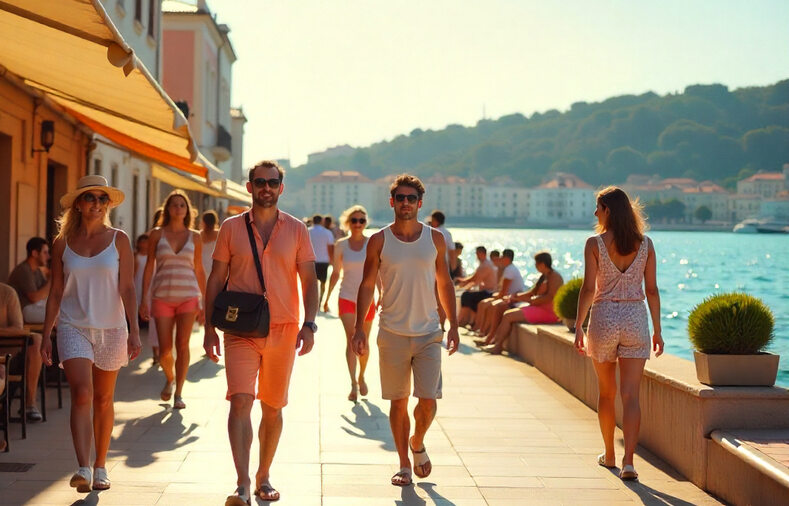Published on
August 24, 2025
Croatia is experiencing a remarkable surge in tourism in 2025, reaching impressive milestones that highlight its status as a top destination for travelers. By August 20, the country had welcomed 15.5 million tourists and recorded 79.2 million overnight stays, marking a 1% increase compared to the same period in 2024. These outstanding numbers have led officials to declare 2025 a “record-breaking year” for Croatian tourism, underscoring its vital importance to the nation’s economy.
The notable rise in both arrivals and overnight stays is matched by a substantial boost in tourist spending. For the period from January to August, tourist expenditure surged by 10.4% compared to the previous year, according to fiscal data. This growth signifies that not only are more tourists visiting Croatia, but they are also contributing more to the economy during their stays.
The financial impact of tourism in Croatia is further emphasized by projections from the central bank, which estimates a 3.6% increase in revenue from international tourists in 2025. The anticipated total revenue from foreign visitors is expected to reach 15.5 billion euros ($18.01 billion), demonstrating the sustained strength of Croatia’s tourism sector.
Tourism plays a crucial role in Croatia’s economic landscape, accounting for approximately 20% of the nation’s GDP. Recognizing this importance, the government and tourism officials are focusing on strategies to extend the tourist season beyond the traditional summer peak. The goal is to diversify tourism opportunities throughout the year, ensuring steady economic activity and a continuous flow of visitors.
One of the key factors driving this growth is Croatia’s strategic focus on expanding its tourism offerings. Beyond the country’s famous Adriatic coastline, rich history, and stunning natural beauty, there has been an emphasis on promoting new experiences. The rise of eco-tourism, wellness retreats, and cultural tourism has attracted a broader range of travelers seeking unique and immersive experiences. These efforts have helped Croatia appeal to a more diverse audience, fueling the rise in both the volume of tourists and the amount of money they spend.
The country’s tourism growth has also been influenced by a combination of factors. Croatia’s improving infrastructure has made it easier for visitors to explore different regions, from its beautiful islands to its vibrant cities and charming villages. Media coverage, international travel campaigns, and the resurgence of post-pandemic travel have all played significant roles in boosting the country’s profile as a desirable destination.
Moreover, Croatia’s tourism sector has seen remarkable improvements in its accessibility. The country is heavily investing in its transportation network, making travel within the country more efficient and seamless. This has made it easier for tourists to visit multiple destinations in one trip, extending their stays and enhancing their overall experience. Such investments not only increase the country’s appeal to international visitors but also help improve the quality of services available to those already enjoying the destination.
The Croatian government is also focused on making tourism a year-round industry, not just a seasonal activity. Efforts to attract off-peak travelers have been supported by campaigns that promote Croatia’s winter and spring offerings, such as skiing in the mountains and cultural experiences in cities like Zagreb. These initiatives are designed to spread tourism revenue more evenly across the calendar year, reducing reliance on the high summer months.
Looking forward, the government is committed to strengthening tourism infrastructure further. Investments in better transportation, new accommodations, and enhanced tourist services are expected to sustain this growth and improve the visitor experience. Croatia is also focused on improving digital tourism tools, including apps and online platforms, to streamline the travel process for visitors.
The impact of tourism in Croatia is not confined to the hospitality industry alone. As more tourists visit, demand rises for retail, food services, and entertainment, creating a ripple effect that benefits the entire economy. Employment in the tourism sector has also risen, providing new job opportunities for locals and contributing to regional economic development.
Overall, Croatia’s tourism sector is experiencing unprecedented growth in 2025, with higher tourist arrivals, extended stays, and a significant increase in spending. These developments not only highlight Croatia’s appeal as a travel destination but also underscore the importance of tourism in driving the country’s economic recovery and growth. By focusing on infrastructure improvements, diversifying its offerings, and extending the tourist season, Croatia is laying the groundwork for continued success in tourism well into the future.
